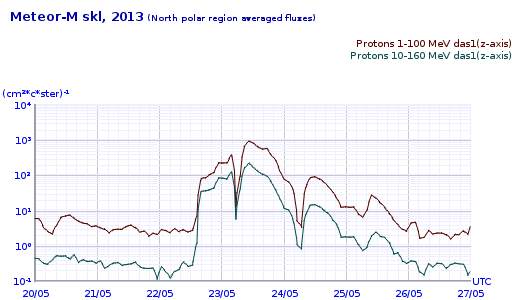 |
Meteor-M no.2
| [Overview] [SKL] [MSGI] [FTP archive] [Charts] [Location] [Trajectory] |

General information
Meteor-M â'- 2 is a satellite manufactured by Joint Stock Company â??Research and Production Corporation Space Monitoring Systems, Information and Control and Electromechanical Complexesâ?T named after A.G. Iosifianâ?T (â??VNIIEM Corporationâ?T JSC) Moscow, Russia.
| Date of launch | 2014.07.08 15:58 UTC |
| Getting to orbit | 2014.07.08 16:57 UTC |
| General characteristics | Orbit parameters | ||
| Total weight | 2778 kg | Apogee | 825 km |
| Launch vehicle | "Soyuz 2.1B" | Perigee | 825 km |
| Launch type | Ground | Inclination | 98,8o |
| Upper Stage | Fregat | ||
| Active life period | 5 year | ||
| Equipment characteristics | |
| Weight | 1200 kg |
Purpose
Global observation of the Earth's atmosphere and surface, allowing to systematically obtain hydrometeorological and heliogeophysical information at planetary scale.
Among other instruments Meteor-M no.2 carries the heliogeophysical hardware package GGAK-M, which brings six a wide range of emission detection instruments to a single platform. These include SGMTD, MIP, DAS-4 and DAS-1 (2 differently directed instruments each). This creates a powerful system for detecting proton and electron fluxes in the near-Earth space.
1. The MSGI-MKA spectrometer is used to measure the following parameters:
- Differential energetic spectra of low-energy electrons (0.05 - 20.0 keV)
- Electron flux density with tuned out proton background in the tens of keV to several MeV range.
- Proton flux density with tuned out electron background in the hundreds of keV to hundreds of MeV range.
MSGI-MKA is built as a single block comprised of two identical units. At any moment only one unit is operating, while the second one is in cold stanby mode.
2. SKL-MKA is used to measure the following parameters:
- Electron flux density with tuned out proton background in the hundreds of keV to several MeV range.
- Proton flux density with tuned out electron background in the hundreds of keV to hundreds of MeV range.
SKL-MKA is built as a single block comprised of two identical units. At any moment only one unit is operating, while the second one is in cold stanby mode.
Z axis is directed from the center of the Earth to the satellite,
X axis is directed as tangential velocity vector
Parameters measured
| # | Name of the spectrometric module | Measurement direction | Detector type | Particle type and energy range | Number of energy ranges measured |
| 1 (MSGI) | SGMTD-30/138E | Z axis | VEU-7 Segmentoid analyser and detector | Electrons (0.05-20.0 keV) | 10 (mode 1) 40 (mode 2) |
| 2 (MSGI) | MIP-1 | Z axis | Gas discharge tube SBT-9 | Electrons >30.0 | 1 |
| 3 (MSGI) | DAS-4 | X axis | Spectrometric module based on semiconductor detectors and a scintillation detector | Electrons (0.1-13MeV) | 6 |
| Protons (1.0-260.0 Ð?Ñ?Ð') | 6 | ||||
| 4 (SKL) | DAS-4 | Z axis | Spectrometric module based on semiconductor detectors and a scintillation detector | Electrons (0.1-13MeV) | 6 |
| Protons (1.0-260.0) MeV | 6 | ||||
| 5 (SKL) | DAS-1 | X axis | Spectrometric module based on semiconductor detectors and a scintillation detector | Electrons
0,1-2 Ð?Ñ?Ð' |
3 |
| Protons
1,0-45 Ð?Ñ?Ð' |
4 | ||||
| 6 (SKL) | DAS-1 | Z axis | Spectrometric module based on semiconductor detectors and a scintillation detector | Electrons
0,1-2 Ð?Ñ?Ð' |
3 |
| Protons
1,0-160 MÑ?Ð' |
4 |
Nominal geometric factor for SKL and MSGI instruments is 0.1, i.e., counts/sec * 10 = flux in units of protons/cm2/sec/ster.
Charged particle fluxes measurement

| : : |

|

|

Developed in 2007. Copyright ¿ 2007 - 2016 Skobeltsyn Institute of Nuclear Physics Moscow State University Feedback